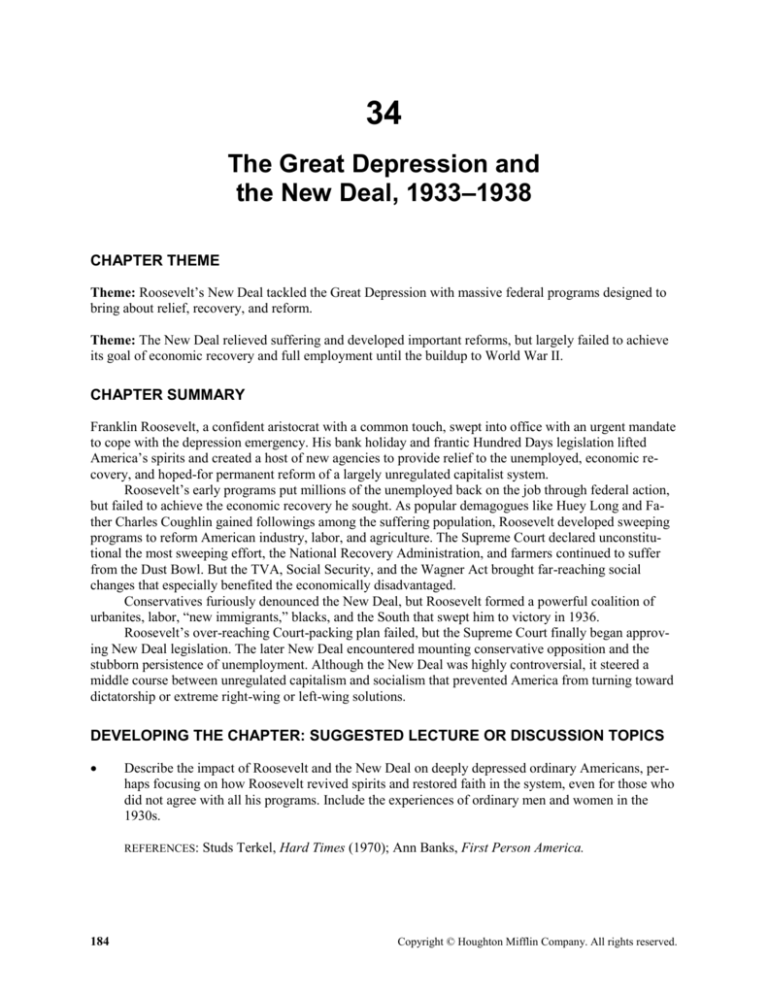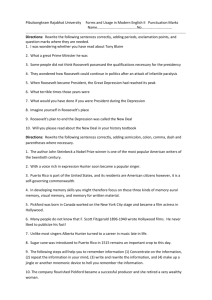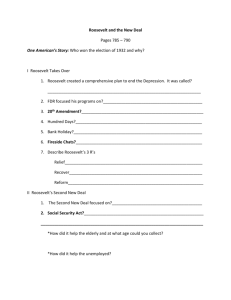
34
The Great Depression and
the New Deal, 1933–1938
CHAPTER THEME
Theme: Roosevelt’s New Deal tackled the Great Depression with massive federal programs designed to
bring about relief, recovery, and reform.
Theme: The New Deal relieved suffering and developed important reforms, but largely failed to achieve
its goal of economic recovery and full employment until the buildup to World War II.
CHAPTER SUMMARY
Franklin Roosevelt, a confident aristocrat with a common touch, swept into office with an urgent mandate
to cope with the depression emergency. His bank holiday and frantic Hundred Days legislation lifted
America’s spirits and created a host of new agencies to provide relief to the unemployed, economic recovery, and hoped-for permanent reform of a largely unregulated capitalist system.
Roosevelt’s early programs put millions of the unemployed back on the job through federal action,
but failed to achieve the economic recovery he sought. As popular demagogues like Huey Long and Father Charles Coughlin gained followings among the suffering population, Roosevelt developed sweeping
programs to reform American industry, labor, and agriculture. The Supreme Court declared unconstitutional the most sweeping effort, the National Recovery Administration, and farmers continued to suffer
from the Dust Bowl. But the TVA, Social Security, and the Wagner Act brought far-reaching social
changes that especially benefited the economically disadvantaged.
Conservatives furiously denounced the New Deal, but Roosevelt formed a powerful coalition of
urbanites, labor, “new immigrants,” blacks, and the South that swept him to victory in 1936.
Roosevelt’s over-reaching Court-packing plan failed, but the Supreme Court finally began approving New Deal legislation. The later New Deal encountered mounting conservative opposition and the
stubborn persistence of unemployment. Although the New Deal was highly controversial, it steered a
middle course between unregulated capitalism and socialism that prevented America from turning toward
dictatorship or extreme right-wing or left-wing solutions.
DEVELOPING THE CHAPTER: SUGGESTED LECTURE OR DISCUSSION TOPICS
Describe the impact of Roosevelt and the New Deal on deeply depressed ordinary Americans, perhaps focusing on how Roosevelt revived spirits and restored faith in the system, even for those who
did not agree with all his programs. Include the experiences of ordinary men and women in the
1930s.
REFERENCES:
184
Studs Terkel, Hard Times (1970); Ann Banks, First Person America.
Copyright © Houghton Mifflin Company. All rights reserved.
The Great Depression and the New Deal, 1933–1938
Examine the goals and activities of the major New Deal programs. The “relief-recovery-reform”
distinction (pp. 781 and 784) is useful for sorting out the alphabet agencies, as is the distinction between the early NRA-AAA approach and the later TVA–Social Security–Wagner Act reforms. A
unifying theme for the whole New Deal is the search to provide greater “security” against the
storms and uncertainties of unregulated capitalism.
REFERENCE:
185
David M. Kennedy, Freedom from Fear (1999).
Explain the various challenges to Roosevelt from both the popular demagogues and the conservatives. Show how he skillfully “stole the thunder” from the former and used the latter as political
whipping boys.
REFERENCE:
Alan Brinkley, Voices of Protest: Huey Long, Father Coughlin, and the Great Depres-
sion (1982).
Consider the experience of women in the Depression and in the making of the New Deal. Look at
both ordinary women in urban and rural areas, as well as more prominent reformers and government figures.
REFERENCES:
Lois Scharf, To Work and to Wed: Female Employment, Feminism, and the Great
Depression (1980); Susan Ware, Beyond Suffrage: Women in the New Deal (1981).
FOR FURTHER INTEREST: ADDITIONAL CLASS TOPICS
Compare and contrast the images and activities of FDR and Eleanor Roosevelt. Show how he pursued realistic political goals, while she took up the cause of the most disadvantaged citizens.
Discuss the particular impact of the depression on women, families, and children.
Use Steinbeck’s The Grapes of Wrath (and perhaps the film) to discuss the plight of Dust Bowl
farmers in the depression. Point out that, for most, the problem was not dust but impossibly low
prices.
Discuss the long-term, continuing impact of the New Deal today. Consider the controversies in the
1980s and after over the legacy of “big government” programs started by the New Deal.
CHARACTER SKETCHES
Franklin Roosevelt (1882–1945)
Roosevelt came from a wealthy patrician family, and his advocacy on behalf of the common person in the
depression led him to be called a “traitor to his class.”
Thoroughly indulged as an only child, Roosevelt was taught primarily by private tutors. His mother,
Sara Delano, was a strong-willed woman who exercised a dominant influence on him even during his
adult life.
Roosevelt had been very athletic before being struck with polio in 1921. It took him several years
of constant effort to regain his strength; after he discovered the therapeutic waters at Warm Springs,
Georgia, he again participated in swimming, fishing, and sailing. Roosevelt was almost never photo-
Copyright © Houghton Mifflin Company. All rights reserved.
186
Chapter 34
graphed in a wheelchair, so many Americans did not know that the wheelchair was his normal means of
getting around.
Roosevelt enjoyed political maneuvering and often pitted his advisers against one another. He once
told two officials with contradictory proposals to “go in a room and weave them together.”
Quote: “In every dark hour of our national life a leadership of frankness and vigor has met with that support and understanding of the people themselves which is essential to victory.…The money changers have
fled from their high seats in the temple of our civilization.…This nation asks for action, and action now.”
(Inaugural address, 1933)
REFERENCE:
Frank Freidel, Franklin D. Roosevelt: Rendezvous with Destiny (1990).
Eleanor Roosevelt (1884–1962)
Besides her role as Franklin Roosevelt’s wife and adviser, Eleanor Roosevelt became an influential reformer and political leader in her own right, both before and after FDR’s death.
Eleanor Roosevelt did not change names when she married her distant cousin. Her father, Elliott
Roosevelt, was Theodore Roosevelt’s younger brother and a troubled alcoholic who separated from his
family when Eleanor was young. Her mother died when Eleanor was eight, and she was raised by a
grandmother who made her feel unattractive and unwanted.
Her discovery of her husband’s unfaithfulness led to a crisis in their marriage and her determination
to create a political identity and career on her own. Her newspaper column, “My Day,” became a highly
popular feature in the 1930s and 1940s. She grew to be a skilled political operator and helped to engineer
the nomination of Adlai Stevenson for president in 1952 and 1956.
Quote: “As time went by, I found that people no longer considered me a mouthpiece for my husband but
realized that I had a point of view of my own with which he might not at all agree. Then I felt freer to
state my views.” (Autobiography, 1949)
REFERENCE:
Blanche Wiesen Cook, Eleanor Roosevelt: A Life (1992).
Huey Long (1893–1935)
Long was the colorful “Kingfish” whose populist politics dominated Louisiana and who eventually challenged Roosevelt’s leadership during the depression.
Originally from rural north Louisiana, Long always had a strong following among poor farmers. He
was elected state railroad commissioner at age twenty-five, and used the office flamboyantly to attack
monopolistic utilities. As governor and senator he ruled Louisiana with near-absolute control; every police officer, firefighter, and teacher in the state owed his or her job directly to Long.
Long spent lavishly for public works, roads, and schools, especially for the “redneck” areas. He
also built up Louisiana State University, with particular emphasis on the football team and the band, and
was known for leading the band on the sidelines during games.
Long would often hold court in hotel rooms in his pajamas, with reporters and advisers and citizens
listening to his clever, humorous, obscene monologues. Long’s plan was to run as an independent presidential candidate in 1936, building a base of support so he could win the White House in 1940.
Copyright © Houghton Mifflin Company. All rights reserved.
The Great Depression and the New Deal, 1933–1938
187
Quote: “Why weep or slumber, America,
Land of brave and true?
With castles, and clothing, and food for all
All belongs to you.
Every Man a King! Every Man a King!” (Radio address, 1935)
REFERENCE: T. Harry Williams,
Huey Long (1981); William Hair, The Kingfish and His Realm: The Life
and Times of Huey P. Long (1991).
QUESTIONS FOR CLASS DISCUSSION
1. Which of Roosevelt’s measures were most effective in fighting the depression? Why?
2. How did Roosevelt alter the role of the federal government in American life?
3. How did the Depression and the New Deal alter the lives of ordinary workers and farmers in the
1930s? Which of the two groups benefited most from the New Deal?
4. What were the positive and negative effects of the New Deal’s use of the federal government as an
agency of social reform?
MAKERS OF AMERICA: THE DUST BOWL MIGRANTS
Questions for Class Discussion
1. In what ways was the migration of the “Okies” and “Arkies” to California similar to European or
Asian immigration to the United States, and in what ways was it different?
2. How does the actual historical experience of the Dust Bowl migrants compare with the fictional portrayal of one such family in John Steinbeck’s The Grapes of Wrath? Is the knowledge that most
Americans have of this migration primarily shaped by that novel?
Suggested Student Exercises
Use a map to trace the Dust Bowl migrants’ route from Arkansas, Oklahoma, and Texas to the San
Joaquin Valley.
Read some of the descriptive passages from Steinbeck’s novel. Consider why he found in these migrants’ experience a suitable subject for a socially conscious work about the Great Depression.
EXPANDING THE “VARYING VIEWPOINTS”
Arthur M. Schlesinger, Jr., The Age of Roosevelt: The Coming of the New Deal (1959).
A view of the New Deal as a radical transformation:
“By bringing to Washington a government determined to govern, Roosevelt unlocked new energies
in a people who had lost faith, not just in government’s ability to meet the economic crisis, but al-
Copyright © Houghton Mifflin Company. All rights reserved.
188
Chapter 34
most in the ability of anyone to do anything. The feeling of movement was irresistible.…A despairing land had a vision of America as it might some day be.… ‘It’s more than a New Deal,’ said Harold Ickes. ‘It’s a new world. People feel free again. They can breathe naturally. It’s like quitting a
morgue for the open woods.’ ‘We have had our revolution,’ said Collier’s, ‘and we like it.’ ”
William E. Leuchtenberg, Franklin D. Roosevelt and the New Deal (1963).
A view of the New Deal as a “halfway revolution”:
“The New Deal achieved a more just society by recognizing groups which had been largely unrepresented—staple farmers, industrial workers, particular ethnic groups, and the new intellectualadministrative class. Yet this was still a halfway revolution. It swelled the ranks of the bourgeoisie
but left many Americans—sharecroppers, slum dwellers, most Negroes—outside the new equilibrium.…The New Dealers perceived that they had done more in those years than had been done in any
comparable period of American history, but they also saw that there was much still to be done,
much, too, that continued to baffle them.”
QUESTIONS ABOUT THE “VARYING VIEWPOINTS”
1. What does each of these historians regard as the fundamental achievement of the New Deal?
2. What weaknesses does Leuchtenberg see in the New Deal?
3. How might each of these historians interpret such programs as the AAA, Social Security, and the
Wagner Act?
Copyright © Houghton Mifflin Company. All rights reserved.









